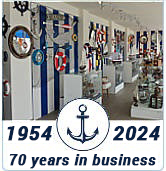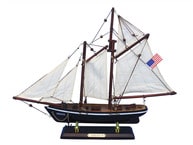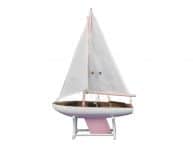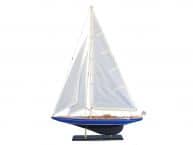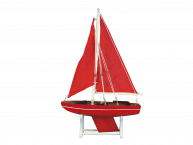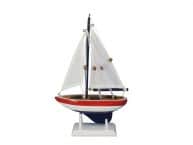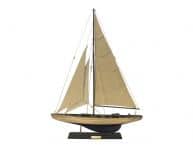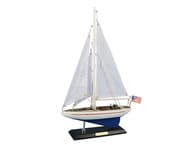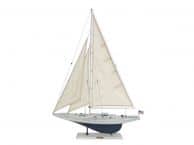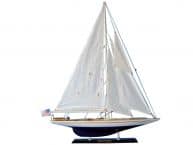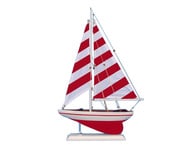|
|
Customers Also Shopped

|
|

|
Wooden America Model Sailboat Decoration 50" Limited
The America was a 19th century racing yacht which gave its name to the international sailing trophy it was the first to win the America's Cup, known then as the Royal Yacht Squadron's "One Hundred Guinea Cup". The schooner was designed by George Steers for Commodore John Cox Stevens and a syndicate from the New York Yacht Club. On August 22, 1851, the America won by eight minutes over the Royal Yacht Squadron's 53 mile regatta around the Isle of Wight. Watching the race, Queen Victoria asked who was second, and received the famous reply: "There is no second, your Majesty."
Designer
The America was designed by George Steers, a revolutionary designer who began the practice of giving ships a knife-like bow widening aft, as opposed to the previous practice of giving ships a rather blunt bow and a sharp stern. His ships repeatedly set records and won races as a result.
Captain
America was captained by Richard Brown, a skilled member of the Sandy Hook Pilots, a group of harbor pilots renowned worldwide for their skill in manoeuvering the shoals around New York City. They were all extremely skilled racers as a result of impromptu races between pilots to ships in need of one. Brown had sailed aboard a pilot boat designed by George Steers, of whom he was a personal friend. He chose as first mate Nelson Comstock, a newcomer to yacht racing.
History subsequent to the race
John Cox Stevens and the syndicate from the New York Yacht Club owned the America from the time it was launched on May 3, 1851 until ten days after it won the regatta that made it famous.
On September 1, 1851, the yacht was sold to John de Blaquiere, 2nd Baron de Blaquiere, who raced her only a few times before selling her in 1856 to Henry Montagu Upton, 2nd Viscount Templetown, who renamed the yacht Camilla but failed to use or maintain her. In 1858, she was sold to Henry Sotheby Pitcher.
Pitcher, a shipbuilder in Gravesend, Kent, rebuilt Camilla and resold her in 1860 to Henry Edward Decie, who brought her back to the United States. Decie sold the ship to the Confederate States of America the same year for use as a blockade runner in the American Civil War, with Decie remaining as captain. During this time, she may have been renamed Memphis, but details are unclear. In 1862, she was scuttled at Jacksonville when Union troops took the city.
She was raised, repaired and renamed America by the Union, and served on the Union side of the blockade for the remainder of the war. After the war, she was used as a training ship at the U. S. Naval Academy. On August 8, 1870, the America was entered by the Navy in the America's Cup race at New York Harbor, and finished fourth.
The America remained in the U. S. Navy until 1873, when it was sold to Benjamin Franklin Butler, a former Civil War Commander, for $5,000. Butler used and maintained the boat well, until his death in 1893, when it was inherited by his son, Paul. The younger Butler had no interest in her, and gave her to his nephew Butler Ames in 1897. Ames reconditioned America and used her occasionally for racing and casual sailing until 1901, when she fell into disuse and disrepair.
The America was sold to a company headed by Charles H. W. Foster in 1917, and in 1921 was sold to the America Restoration Fund, who donated her to the U. S. Naval Academy in Annapolis. She was not maintained there either, and by 1940 had become seriously decayed. On March 29, 1942, during a heavy snowstorm, the shed where the America was being stored collapsed. Three years later, in 1945, the remains of the shed and the ship were finally scrapped and burned.
 Handcrafted
Handcrafted Handcrafted
Handcrafted Handcrafted
Handcrafted Handcrafted
Handcrafted Handcrafted
Handcrafted Handcrafted Model Ships
Handcrafted Model Ships




